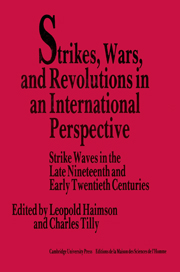 Strikes, Wars, and Revolutions in an International Perspective
Strikes, Wars, and Revolutions in an International Perspective Book contents
- Frontmatter
- Contents
- List of contributors
- Preface
- Part I Introductions
- Part II Models and realities
- Part III Workers in metal-processing enterprises in comparative perspective
- Part IV The effects of short-term variation
- 18 Introduction
- 19 Economic cycles and labor conflicts in Germany during the first quarter of the twentieth century
- 20 The crisis of state and society in Britain, 1917–1922
- 21 Strikes and the war
- 22 Labor unrest in Imperial Russia on the eve of the First World War: the roles of conjunctural phenomena, events, and individual and collective actors
- 23 Strikes in Russia, 1917: the impact of revolution
- Part V Conclusion
22 - Labor unrest in Imperial Russia on the eve of the First World War: the roles of conjunctural phenomena, events, and individual and collective actors
Published online by Cambridge University Press: 25 March 2010
- Frontmatter
- Contents
- List of contributors
- Preface
- Part I Introductions
- Part II Models and realities
- Part III Workers in metal-processing enterprises in comparative perspective
- Part IV The effects of short-term variation
- 18 Introduction
- 19 Economic cycles and labor conflicts in Germany during the first quarter of the twentieth century
- 20 The crisis of state and society in Britain, 1917–1922
- 21 Strikes and the war
- 22 Labor unrest in Imperial Russia on the eve of the First World War: the roles of conjunctural phenomena, events, and individual and collective actors
- 23 Strikes in Russia, 1917: the impact of revolution
- Part V Conclusion
Summary
The analyses presented in the second part of this volume have centered attention on the role played by structural processes of change – in the character, organization, and relations of production and the social characteristics of the work forces involved in them – in accounting for changing patterns of labor unrest in Imperial Russia after the turn of the century. In other of my writings to date, I have laid emphasis on the role played by other structural processes: most notably, in the case of the workers of St. Petersburg, on the demographic changes attendant to the emergence after 1905 of more stable, and more coherent working-class communities in certain parts of the capital, and their effects on the patterns of strike actions displayed by the workers concentrated in them.
This is not to suggest, however, that any adequate interpretation of the dynamics of this labor unrest can in fact be drawn by focusing exclusive attention on structural processes of change. Even from a purely statistical standpoint, as we shall see, our analyses have exposed major differences between the 1912–14 strike wave, and the strikes that unfolded in 1911, and indeed during the three months of 1912 immediately preceding the Lena goldfield massacre. And as the contributions of William Rosenberg and Diane Koenker to this volume amply suggest, the dynamics of industrial strikes in the course of the Revolution of 1917 would unveil equally important differences as well as similarities with those that we scrutinized between Lena and the outbreak of the war.
- Type
- Chapter
- Information
- Strikes, Wars, and Revolutions in an International PerspectiveStrike Waves in the Late Nineteenth and Early Twentieth Centuries, pp. 500 - 511Publisher: Cambridge University PressPrint publication year: 1989
